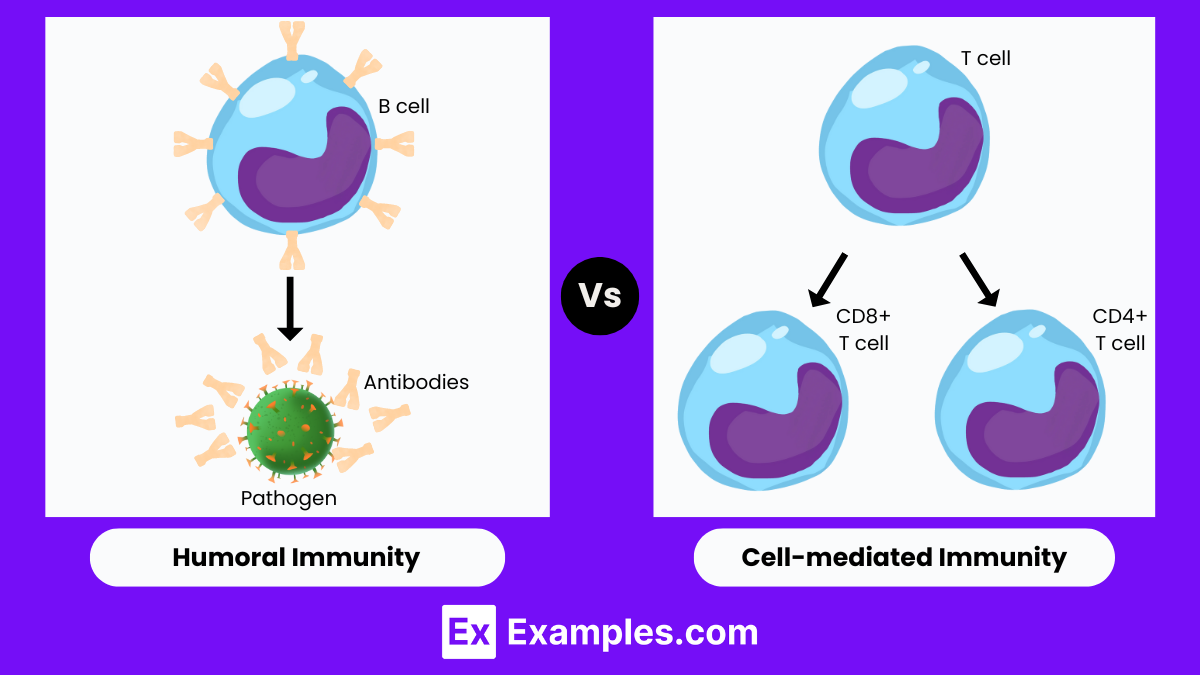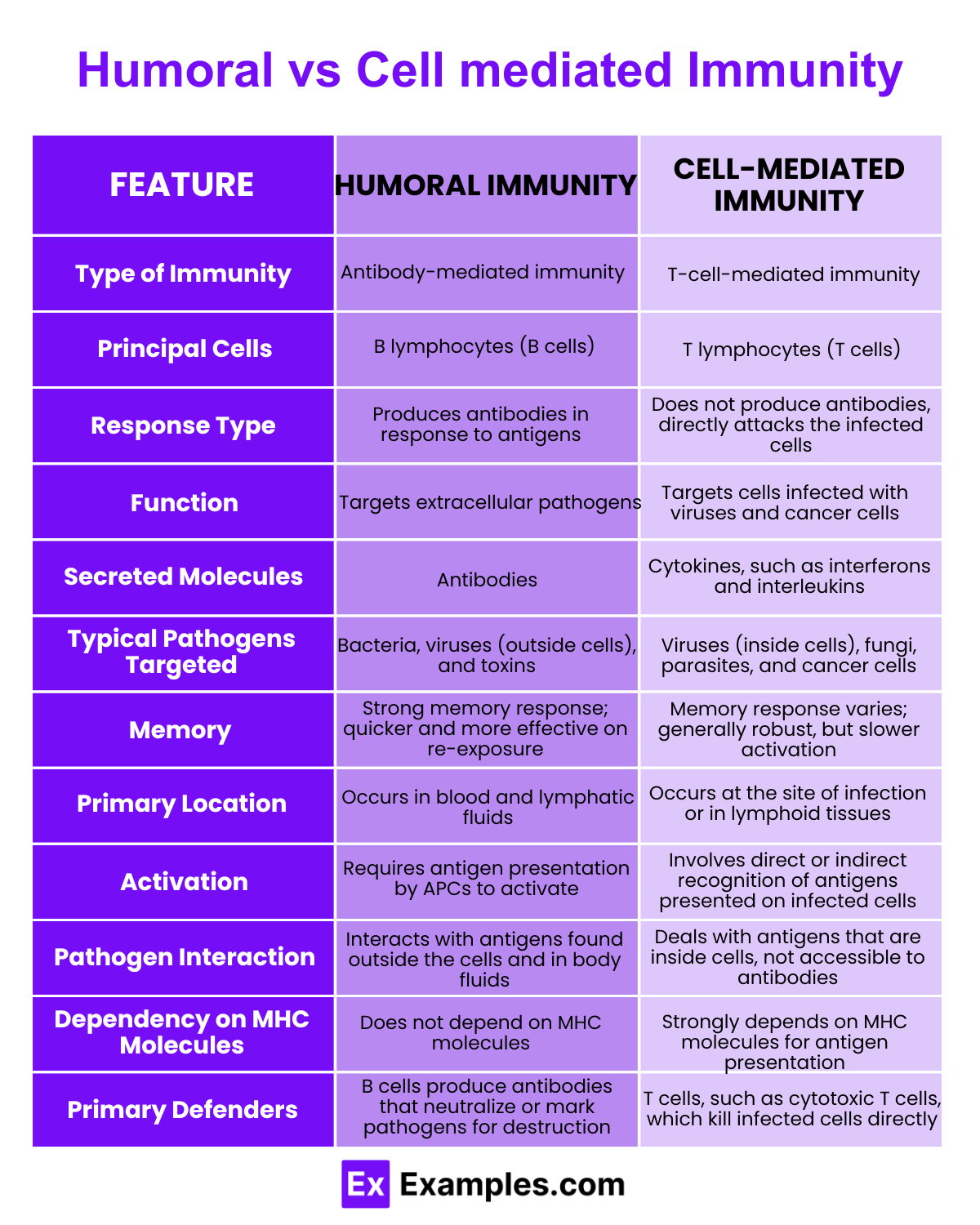Which type of immunity involves B cells?
Humoral immunity
Cell-mediated immunity
Both
Neither


Immunity protects against disease through two main types: humoral immunity and cell-mediated immunity. Humoral immunity involves antibodies produced by B cells to neutralize pathogens, effective against external invaders. In contrast, cell-mediated immunity relies on T cells to kill infected cells and manage the immune response, crucial for fighting intracellular pathogens. These systems work together to provide robust and lasting protection against a variety of infections.
Humoral immunity is a crucial component of the adaptive immune system, primarily involving antibodies produced by B cells to defend against extracellular pathogens like bacteria and viruses. This process starts with the activation of B cells upon encountering an antigen, followed by their transformation into plasma cells that produce and secrete antibodies. These antibodies neutralize pathogens by blocking their entry into cells, mark them for destruction, and activate the complement system to enhance pathogen elimination. Humoral immunity also generates memory B cells, which enable a faster and more effective response upon subsequent exposures to the same pathogen, forming the basis of vaccine efficacy and long-term immunity.
Humoral immunity is vividly illustrated by the body’s response to the flu vaccine, which introduces inactive or weakened flu virus antigens that stimulate B cells to produce antibodies specific to these antigens. Upon vaccination, these B cells differentiate into plasma cells, which flood the bloodstream with antibodies ready to neutralize any future flu virus encounters by preventing the virus from entering cells and marking it for destruction. This response not only provides immediate protection but also generates memory B cells that enable a rapid and robust antibody production if the flu virus is encountered again, showcasing the critical role of humoral immunity in both immediate defense and long-term immunity against common pathogens like the flu.
Cell-mediated immunity is a crucial branch of the adaptive immune system that relies on T cells to combat intracellular pathogens, such as viruses and some bacteria, that hide within host cells. This form of immunity involves the direct action of cytotoxic T cells (CD8+), which kill infected cells by inducing apoptosis, and helper T cells (CD4+), which assist by producing cytokines to amplify the immune response. Unlike humoral immunity, which uses antibodies to fight pathogens, cell-mediated immunity does not involve antibodies but focuses on eliminating infected or dysfunctional cells directly. This is vital not only for controlling infections but also for tumor surveillance and managing autoimmune responses, with memory T cells providing long-term immunity against previously encountered pathogens.
Cell-mediated immunity plays a crucial role in the body’s defense against intracellular pathogens, such as viruses and some bacteria that reside within cells. For example, when the body is infected with the virus that causes tuberculosis, cell-mediated immunity is activated. T cells, particularly CD8+ cytotoxic T cells, recognize and destroy the infected cells to prevent the spread of the virus. Additionally, CD4+ helper T cells enhance the immune response by producing cytokines that help activate other immune cells. This targeted response not only helps to clear the infection but also creates memory T cells that provide quicker and more effective protection in case of future exposures to the same pathogen.

| Aspect | Humoral Immunity | Cell-Mediated Immunity |
|---|---|---|
| Type of Immunity | Antibody-mediated immunity | T cell-mediated immunity |
| Defensive Strategy | Produces antibodies that neutralize pathogens | Utilizes T cells to directly attack infected cells and regulate immune responses |
| Main Components | B cells, antibodies, plasma cells | T cells (CD4+ helper T cells, CD8+ cytotoxic T cells), macrophages |
| Pathogens Targeted | Effective against extracellular pathogens like bacteria and viruses in body fluids | Targets intracellular pathogens, such as viruses and bacteria residing within cells |
| Mechanism | Antibodies bind to pathogens to neutralize or mark them for destruction by other cells | T cells destroy infected host cells, activate other immune cells |
| Role of Cells | B cells mature into plasma cells that produce antibodies | T cells differentiate into various types based on function and target |
| Memory | Generates memory B cells that enhance speed and efficiency of future immune responses | Produces memory T cells that quickly respond to previously encountered pathogens |
| Primary Function | Prevents pathogen entry, neutralizes toxins, and stops pathogen spread | Kills infected cells, important for controlling and eliminating infections |
| Immune Response Type | Often the first response to pathogens and crucial for long-term immunity | Essential for immediate defense, especially against persistent or latent infections |
| Examples | Response to most vaccinations, such as those for influenza or hepatitis B | Response to tuberculosis or viral infections like herpes simplex virus |
Humoral and cell-mediated immunity are two pillars of the adaptive immune system, each playing distinct roles in protecting the body against pathogens. Despite their differences, they share several fundamental similarities:
Both humoral and cell-mediated immunity are components of the adaptive immune system. This means they are highly specific to the pathogens they target and involve a memory component that makes the immune system quicker and more effective upon subsequent exposures to the same pathogen.
At the core of both types of immunity is the recognition of specific antigens. B cells in humoral immunity and T cells in cell-mediated immunity are each equipped with unique receptors that recognize specific antigens, ensuring that the immune response is targeted and specific.
Both responses are mediated by types of lymphocytes. B cells drive humoral immunity by producing antibodies, while T cells drive cell-mediated immunity through direct cellular interactions and cytokine release.
Both types of immunity generate memory cells that provide long-lasting protection. Memory B cells in humoral immunity and memory T cells in cell-mediated immunity can persist for years, enabling a faster and more robust response to re-infection by the same pathogen.
Humoral and cell-mediated immunities do not operate in isolation but interact and collaborate to mount a comprehensive immune response. For example, helper T cells (a component of cell-mediated immunity) assist in the activation and differentiation of B cells, enhancing antibody production, which is crucial for effective humoral immunity.
Both humoral and cell-mediated immunities are critical for the efficacy of vaccines. Most vaccines aim to elicit both B cell (antibody-mediated) and T cell responses to ensure comprehensive protection against pathogens.
Ultimately, both arms of the immune system work towards the same goal: the elimination of pathogens and the protection of the body from diseases. While their mechanisms may differ, the end goal of maintaining health and combating infections unites them.
Humoral immunity involves antibodies in body fluids, while cell-mediated immunity relies on T-cells to combat pathogens.
Quizlet explains that humoral immunity uses antibodies, whereas cell-mediated immunity involves T-cells to protect the body.
An example of cell-mediated immunity is T-cells destroying virus-infected cells, providing targeted defense against pathogens.
Humoral immunity can be both active, following exposure to an antigen, and passive, through antibodies transferred from mother to child.
Both types of immunity are essential; humoral immunity blocks pathogens externally, while cell-mediated immunity destroys infected cells internally.
Text prompt
Add Tone
10 Examples of Public speaking
20 Examples of Gas lighting
Which type of immunity involves B cells?
Humoral immunity
Cell-mediated immunity
Both
Neither
Cell-mediated immunity is primarily associated with which cells?
B cells
T cells
Macrophages
Red blood cells
Antibodies are produced by:
T cells
B cells
Macrophages
Natural killer cells
Which type of immunity is most effective against intracellular pathogens like viruses?
Humoral immunity
Cell-mediated immunity
Both
None
Humoral immunity primarily targets:
Extracellular pathogens
Intracellular pathogens
Both
None
Helper T cells play a role in:
Humoral immunity
Cell-mediated immunity
Both
Neither
Which of the following is a function of cytotoxic T cells?
Produce antibodies
Kill infected cells
Phagocytosis
Produce cytokines
Memory cells are formed in:
Humoral immunity
Cell-mediated immunity
Both
Neither
Vaccines typically stimulate which type of immunity?
Humoral immunity
Both
Cell-mediated immunity
Neither
Which cells act as antigen-presenting cells (APCs) to initiate an immune response?
Macrophages and dendritic cells
T cells
B cells
Red blood cells
Before you leave, take our quick quiz to enhance your learning!

